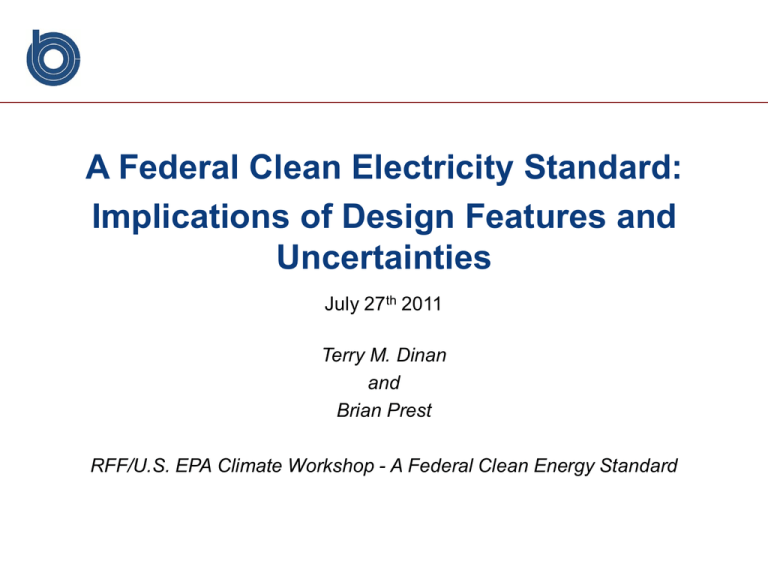A Federal Clean Electricity Standard: Implications of Design Features and Uncertainties
advertisement

A Federal Clean Electricity Standard: Implications of Design Features and Uncertainties July 27th 2011 Terry M. Dinan and Brian Prest RFF/U.S. EPA Climate Workshop - A Federal Clean Energy Standard Study Objective and Method Understand how design features and varying assumptions about future costs affect: – Regional power generation – U.S. CO2 emissions – Regional electricity prices Findings based on: – Apples-to-apples comparisons of existing studies that differ with respect to: • Design features • Cost assumptions and resource availability 1 Seven Analyses Used for Comparison Three 25 percent RES Policies – With triple credits for solar PV (EIA/NEMS) – With triple credits for solar PV (NREL/ReEDS) – Without triple credits (RFF/NEMS) Two 20 percent RES Policies (RFF/Haiku) – With $25 ACP – Without $25 ACP Two 25 percent CES Policies (RFF/NEMS) – No credits for natural gas – Partial credits for incremental natural gas Focus not on particular policies, but on isolating effect of design features 2 Other Key Observations about Design Features All analyses assumed: – Standards phased in, no banking or borrowing – Full trading – State standards fully implemented All analyses run using NEMS assumed $50 ACP, but had little effect on outcomes. 3 Results of Seven Analyses Mapped into Five Consistent Regions NE WEST P L A I N S East Central Southeast 4 Percent of Qualifying Generation, Pre- and Post-Policy for Final Year of Projection 25% RES Triple Credits 20% RES Triple No Triple Credits Credits Exemption for Small Utilities Optimistic Cost Effect W/ACP W/O ACP ACP Effect 25% CES No NG W/NG Partial Credits Effect Triple Credits 5 Policy-Induced Change in Renewable Generation for Final Year of Projection, by Source (billions of kWh) 25% RES 450 EIA (NEMS) NREL (ReEDs) 25% CES 20% RES RFF (NEMS) w/ ACP (Haiku) w/o ACP (Haiku) No NG (NEMS) w/ NG (NEMS) 400 350 300 250 200 Triple Credits 150 100 50 0 Wind Biomass Geothermal Solar 6 Policy-Induced Change in Renewable Generation for Final Year of Projection, by Region (billions of kWh) 200 180 25% RES EIA (NEMS) NREL (ReEDS) 25% CES 20% RES w/o ACP (Haiku) RFF (NEMS) w/ ACP (Haiku) Southeast East Central No NG (NEMS) w/ NG (NEMS) 160 140 120 100 80 60 40 20 0 -20 Northeast Plains West 7 Policy-Induced Change in Electricity Prices, by Region (percent) 25% RES 12 10 EIA (NEMS) NREL (ReEDS) 20% RES RFF (NEMS) w/ ACP w/o ACP (Haiku) (Haiku) 25% CES No NG (NEMS) w/ NG (NEMS) 8 6 Northeast 4 2 0 Southeast East Central Plains West -2 -4 -6 8 Features Helpful in Minimizing Cost of Reducing CO2 Emissions through an RES or CES Wide range of eligible sources – Effect of CES versus RES – Effect of including natural gas (with partial credits) – Effect of including existing sources • Cost effects • Distributional effects Free Trading of Credits – Trading by third parties – Derivatives Gradual and Flexible Timing – Phasing in the standard – Banking and Borrowing 9 For More Information See…. The Effects of Renewable or Clean Electricity Standards Available at: http://www.cbo.gov/doc.cfm?index=12166 10



